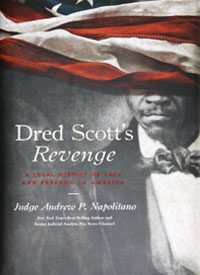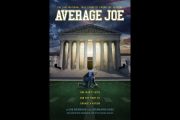
Even though Napolitano has been working as a legal analyst for Fox News since 1998, he hasn’t been afraid to challenge the establishment status quo. He has articulately and passionately criticized practically all of the unconstitutional innovations of the “War on Terror,” which have been embraced by the “conservative” mainstream media. His principled positions have drawn the ire of members of the establishment right but earned him the admiration and respect of his faithful fans.
Napolitano is also a best-selling author of four books — Constitutional Chaos, Constitution in Exile, A Nation of Sheep, and Dred Scott’s Revenge — that expose the unconstitutionality of our present government. The latter, the subject of this review, is subtitled “A Legal History of Race and Freedom in America.” It not only continues his constitutional theme but also explores the very difficult issue of race-based discrimination and demonstrates once again that Napolitano is not afraid to challenge the establishment consensus by taking on a volatile subject.
Napolitano, a former Superior Court judge in New Jersey, proudly proclaims his personal devotion to the concept of natural law. “Natural law teaches that our rights come from our humanity. Since we are created by God in His image and likeness, and since He is perfectly free … freedom is our birthright. Thus, the natural law informs that freedom comes from our humanity, not from any outside source, like, for example, the government.” Napolitano distinguishes this from positive law that “teaches that the law is whatever the lawgiver says it is, providing it is written down.”
It is Napolitano’s strong adherence to his understanding of natural law that prompts him, in this book, to embrace judicial activism over judicial restraint in cases where the law in question conflicts with his personal belief: “Is it the role of the courts to sidestep the positive law of the land when natural law is violated? My own view, shared by some giants throughout history (and rejected by others) is an unequivocal: YES.” Because of this stance, Napolitano openly praises federal actions that he acknowledges are unconstitutional by constitutionalist standards, such as the Civil Rights Act of 1965 and the Supreme Court decision Brown v. Board of Education.
Notwithstanding Natural Law
He begins the book by pointing out the abuses of natural law that are embedded in the Constitution and by exploring the conception of slavery in this nation, its growth, and all the surrounding political implications. Napolitano delves into what he characterizes as the Constitutional Convention’s greatest failures: the Three-Fifths Compromise (Article I, Section 2, Clause 3, which controls the apportionment of representatives allowing for slaves to be counted as three-fifths a person, giving slave-holding states more political power), the Fugitive Slave Clause (Article IV, Section 2, Clause 3, which authorized the return of runaway slaves), and the Importation Clause (Article I, Section 9, Clause 1, which extended the importation of slaves into the United States until 1808). The aforementioned clauses, when taken together, “provided the federal justification necessary to perpetuate slavery and government-sponsored racism in its most extreme incarnation,” he writes. Even with this though, Napolitano argues that the Founders didn’t really have the option to take a strong stance against slavery because it would have made ratification impossible.
Napolitano then explores the contentious debates over allowing or prohibiting slavery in the territories, as well as famous court cases that dehumanized blacks and reduced them to mere property. The most well-known case of its kind and the namesake for the book, Scott v. Sanford, involved a slave named Dred Scott who was taken into free territory where he sued for his freedom on the grounds that being on free soil resulted in his emancipation. Chief Justice Roger Taney ruled, in an opinion of the court, that Scott was not a U.S. citizen, because the makers of the Constitution had not intended for Blacks to be considered citizens, and therefore did not meet the court’s jurisdictional requirement. The significance of this case though is not really in regards to Scott’s fate (he was freed by his owner shortly after the case was concluded anyway). Rather it was owing to the rest of Taney’s opinion, which involved obvious usurpation by the court.
When Taney ruled there was a lack of jurisdiction, the legal discourse on the case should have ended. Taney should have stopped there, but in a blatant act of judicial supremacy, he went further and declared that any federal action to prohibit slavery in a territory, such as the Missouri Compromise, was a violation of the Fifth Amendment’s Due Process Clause and therefore unconstitutional. To say the least, the ruling was faulty on constitutional grounds because at the time of the ratification of the Bill of Rights, the Northwest Ordinance was in effect, which prohibited slavery in the territories. This illustrates, contrary to Taney’s reasoning, that Congress did indeed have the ability. Though this ruling did not have any practical legal effect because the Kansas-Nebraska act had already replaced the Missouri Compromise (which left the issue of slavery in the territories up to “popular sovereignty,” meaning the residents could decide if there would be slavery or not), it was momentous because the court now claimed the federal government lacked any power to prohibit slavery at all. This outraged the Republican Party, which had the prohibition of slavery in the territories as one of its main purposes.
Another legacy of Taney’s Scott decision, and his judicial activism, was that this ruling would lay the groundwork for the election of Abraham Lincoln, who promptly ignored the limitations placed upon him by the Constitution and took the country to war, instead of allowing states to secede — a right of states that Napolitano defends, along with the rights of states to nullify unconstitutional laws: “The right of secession followed from the American Revolution as the colonists separated from the British Empire and declared their independence…. Nullification was also a fundamental state right to prevent federal domination. States enjoyed the right to use nullification as a protective measure against unconstitutional federal laws by making them ineffective against their citizens. Nullification had become a states’ right tradition, and both the North and the South exercised it prior to 1861.” Such truthful statements are unheard of among mainstream pundits who belong to what historian Thomas DiLorenzo calls the “cult of Lincoln.”
Establishment historians deify Lincoln as an almost God-like figure who “saved the Union,” but Napolitano again shows his willingness to go against the grain by discussing in-depth many of the inconvenient facts about the person numerous historians glowingly refer to as “the great emancipator.” “The common tale that Lincoln was a sympathetic and heroic defender of black freedom is simply a myth…. Enshrining Lincoln as the Great Emancipator obscures a more complicated and less pleasant truth: Lincoln had the same racist tendencies as other whites in those days and cared solely about preserving the Union, not freeing the slaves.”
Napolitano definitely does not buy in to the establishment consensus that Lincoln’s actions were admirable. Instead, he argues that the violent and deadly actions taken by Lincoln only intensified the deep racism in the Confederate states that would later manifest itself as “Jim Crow” laws (government-mandated segregation) in the post-Reconstruction south. But Napolitano’s willingness to challenge a politically correct version of history over even someone as popular as Lincoln does not stop Napolitano from taking the politically correct path later in his book — when recounting the times that the Supreme Court did act unconstitutionally in an alleged attempt to aid Blacks.
Analysis Off Track
It is at this point in his analysis that Napolitano begins to diverge from the anti-establishment thinker he is well-known for into more of a standard historian. While he is dead-on in his thorough recounting of the disgusting injustices of government-endorsed racism, he also accepts the notion that the only solution was to involve a bigger government, namely the federal government, even if this involved the judicial activism of the Warren Court or unconstitutional acts of Congress. Even though he acknowledges the constitutionalist criticism of these positions (he even quotes Barry Goldwater), he defends them as necessary to combat racist government policy. For some of his fans, this argument might be viewed as trying to have it both ways by being a buffet-style constitutionalist. That is, follow the Constitution when you personally agree with it and ignore it when you don’t.
Dred Scott never seems to recover after these chapters as Napolitano continues his fence-sitting. He proceeds up to the modern day detailing perceived racism that government must be allowed to fix, while ignoring the problems the government’s racial fixes have caused: the prevalent reverse racism of modern affirmative action programs. Napolitano ends on an optimistic note, asserting that our first black president might be able to usher in an era of a post-racial America, although one might think that the very election of a black president by the masses should indicate that Americans — but not the American government — are already in a post-racial era.
It is hard for this reviewer to share Napolitano’s optimism when “racial equality” and “civil rights” are synonymous for many with unconstitutional federal actions. Napolitano’s line of analysis, while commonplace, wholly ignores any solution to these problems that doesn’t involve more government intervention. Anyone looking for an alternative view should read the works of George Reisman (Capitalism: The Cure for Racism) and Thomas Sowell (Civil Rights: Rhetoric or Reality?), as well as the writings of George Mason University Professor Walter E. Williams and University of Chicago Law Professor Richard Epstein, who have both done an excellent job dissecting the necessity of government intervention in race-based matters.
Overall, even though the book is a mixed bag, the first half is extremely strong and worth reading. Napolitano should also be commended for taking the aforementioned controversial stands.
Perhaps a fruitful subject for Napolitano’s next book could be the topic of abortion that, much like slavery, he personally opposes as an obvious violation of natural law: “The Dred Scott case is widely considered to be one of the greatest disasters in Supreme Court history because it defined blacks as non-persons. It would be followed by similar disasters in which Japanese-Americans (in U.S. v. Korematsu [1943]) and babies in the womb (in Roe v. Wade [1973]) would also be held by the Court to be non-persons.” Drawing parallels to justified killings of self-defense, Napolitano writes, “The intentional killing of a baby, for example, can never be right; a baby is the embodiment of innocence and is in no position to have his or her right to life stripped.” Such proclamations are only the starting point for a book that could break new ground.
Dred Scott’s Revenge: A Legal History of Race and Freedom in America, by Judge Andrew P. Napolitano, Nashville, Tennessee: Thomas Nelson, Inc., 2009, 253 pages, $25.99.



